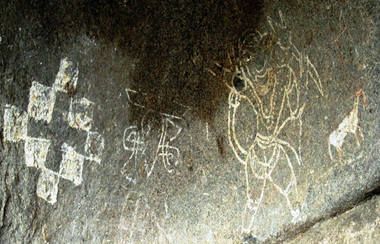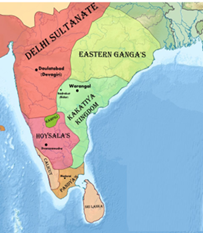

Context
Recently, a painting from Kakatiya-era drawn in a natural rock shelter on the Rudragiri hillock depicts several evidences from the Ramayana.
- The site unveils a combination of prehistoric rock paintings from the Mesolithic period and exquisite artwork from the Kakatiya dynasty.

About Rudragiri caves:
- Rudragiri hillock is located in the village of Orvakallu, in Guntur district of Andhra Pradesh.
- The shelters are found in the hillock which earlier was served as living quarters for people during the Mesolithic age around 5000 B.C., and they bear witness to the luminous rock paintings of that era.
- Interestingly, two natural caves at the southern end of the hillock also exhibit exceptional murals from the renowned Kakatiya kingdom.
Findings from the site:
- The first cave, starting from the southern end of the hillock, presents a narrative mural portraying the intense battle between the Vanara brothers, Vali and Sugriva.
- In the middle cave, a grand sketch of Hanuman, accompanied by sacred symbols of the conch (Sankha) and the fire altar (Yagna Vedi) is present. Hanuman is depicted carrying the Sanjivani hill in his right hand, symbolising his mission to save Lakshmana’s life.
- The third cave houses the prehistoric rock paintings from the Mesolithic era.
The Kakatiya Dynasty:
- Kakatiyas is a dynasty from Andhra Pradesh that flourished in the 12th century CE. The Kakatiya dynasty ruled from Warangal (Telangana) from CE 1083-1323.
- They were known for the construction of a network of tanks for irrigation and drinking water and thereby gave a big boost to the overall development of the region.
- The Delhi Sultanate’s Alauddin Khilji invaded the Kakatiya region in 1303, which resulted in disaster for the Turks.
- The Kakatiya army put up a brave fight against Ulugh Khan’s second assault in 1323, but they were ultimately overcome.
- Architecture: A distinctive architectural style was also developed during the Kakatiya era; notable examples include the Warangal Fort, the Thousand Pillar Temple in Hanamkonda, the Ramappa Temple in Palampet, and the Kota Gullu in Ghanpur.
- Inscriptions, including about 1,000 stone inscriptions and 12 copper-plate inscriptions, provide a lot of information about the Kakatiya era.


